-

人教版新目标初中英语八年级下册What were you doing when the UFO arrived教案2篇
(一).知识方面: 1.培养学生能运用过去进行时来描述、谈论过去某个时间正在发生的事情或动作的意识和能力,能就过去某个时间正在发生的动作做出正确的描述。 2.培养学生的想象力和角色扮演的合作能力。 3.培养学生讲述过去发生的事情经过的能力。能正确运用一般过去时来讲述故事。 (二).技能方面: 1.本单元的语言目标是Talk about past events and tell a story(谈论过去的时间和讲述一个故事),围绕这一目标,要涉及句型: What were you doing when the UFO arrived? ----I was sitting in the barber’s chair. The barber was cutting my hair. 因此必须学习standing、studying、cleaning、sleeping、cooking、making、eating、cutting、等表示地点的词,以便为上述句型提供语言材料。2.学习过去进行时的有关知识。Was/were+现在分词,是该时态的表达式。 3.在学习过程中,要区分The boy was walking down the street when the UFO landed.和While the boy was walking down the street, the UFO landed.这两种由when和while引导的状语从句的句型结构。注意它们的不同。

人教版新目标初中英语八年级下册Why don’t you get her a scarf教案
教师带领学生复习有关描述宠物的词汇,采用教师提问学生回答的方进行。如:T:What animals do you think would be good pets?What animals do you think would be bad pets?What do you think are good animals for a six-year-old child?然后学生进行 pairwork 练习。Task two: 师生互动,学习探究 1、播放3a部分的录音,引导学生一边听录音,一边跟读。2、通过听录音学生回答以下问题:Why do you think pot-bellied pigs are popular?What are the advantages and disadvantages of keeping such a pet?教师对学生的回答进行及时点评。3.学习范文,学习重点短语,为下步的模仿写作提供语言素材。T :1. )Have you ever kept a pig as a pet?Do you like pigs? St.:No.…Why don’t you like to keep a pig? St: No.They’re too dirty and lazy(Do you know in some foreign countries like Hollyland, Australia,pigs are the most popular pet.there’s a kind of pig.(图)it has an interesting name? it ‘s called a pot-bellied pig.) Now,let’s learn an article about this kind of interesting pet.2.)play the tapeSt.:Listen and repeat3.)show some Qs on computer(本子St.: read silently,then answerthe Qs(本子)4.)Ask ss. Close book and retell this passage.(what is a pot-bellied pig? Is it a good or bad pet? ) St.: retell it to each other“A pot –bellied pig is a popular pet now…”5.read the article together.St.:.practice reading

人教版新目标初中英语八年级下册Would you mind turning down the music教案
Step 4. Group work (4)1. Ask a pair of students to read the dialogue. Say, This activity provides speaking, listening and writing practice using the target language.2. Ask students to complete the work in groups.3. Check the answers with the whole class. 4. Explain some of the language points. Step 5. Word review (Self check 1)1. Ask students to read the words and the phrases given. 2. Fill in the blanks with proper forms of these words to complete the sentences. 3. Check the answers with the whole class. Homework:Do activity 2 on page 57 after class. Period 6Teaching aims: 1. Teach vocabulary words and the useful expressions. 2. Enable the students to learn etiquette in different culture. 3. Help the students learn how to behave politely in public places and in daily life. Teaching procedures:Step 1. RevisionHelp students to review the function of making requests through a free talk. Then lead them to the topic of etiquette. Explain the meaning of etiquette. Or, ask students to look it up in the dictionary. Step 2. Pre-reading (Section 1)1. Ask students to read the picture and make a list with their partner about how many rules of etiquette can be seen being broken.

人教版新目标初中英语九年级下册By the time I got outside, the bus had already left教案
Ⅰ. Teaching Aims and Demands1. Knowledge Objects(1) Key Vocabularyoversleep(2) Target LanguageWhat happened?I overslept. And by the time I got up, my brother had already gotten in the shower.2. Ability Objects(1) Teach the students to use the new words.(2) Train the students to narrate past events with the Past Perfect Tense.(3) Train the students' listening and speaking skills with the target language.3. Moral ObjectIt’s a good habit to go to bed early in the evening and get up early in the morning. So you’ll never be in a hurry in the morning.Ⅱ. Teaching Key Points1. Key Vocabularyoversleep2. Target LanguageNarrate past events with the Past Perfect TenseⅢ. Teaching Difficult Points1. Train the students to narrate past events with the Past Perfect Tense.2. Train the students to understand the target language in spoken conversation.Ⅳ. Teaching Methods1. Thinking of examples from the students' real lives.2. Making sentences by looking at the pictures.Ⅴ. Teaching AidA tape recorderⅥ. Teaching ProceduresStep I Revision1. Revise the language points in Unit 8.Ask some questions like this: What volunteer work would you like to do?Help the students to answer, I’d like to…/I love to…/I hope to2. Practice the dialogue in Activity 3c on page 62 again. Get students to role play the similar dialogues with the following.

人教版新目标初中英语九年级下册Rainy days make me sad教案
1. 教材分析本单元以how do things affect you?为话题, 从颜色、天气、音乐、广告、产品等方面谈论了外界事物如何影响人的心情。要求学生掌握表达某物或某事给人带来的感觉、看法或影响等。共设计了四个部分的内容:Section A 该部分有4个模块:第一模块围绕Which restaurant would you like to go to?这一话题展开思维(1a)、听力(1b)、口语(1c)训练;第二模块围绕How does music affect you? 进行听力(2a-2b)、口语训练(2c);第三模块继续围绕how do colors in the restaurant affect you这一话题展开训练,训练形式为阅读和问题体验(3a)和小组活动(3b);第四模块仍就How do things affect you这一话题以调查的形式展开讨论。Section B该部分有4个模块:第一模块围绕产品广告对人们的影响这一话题以“配对”(1a)与“列举”(1b)两种形式展开训练;第二模块继续围绕How do things affect you? 进行听力(2a-2b)、口语对话训练(2c);第三模块围绕“Advertising”这一话题展开阅读(3a-3b)和写作(3c)训练;第四模块围绕How posters affect you这一话题以口语训练形式展开小组活动。

人教版新目标初中英语九年级下册Could you please tell me where the restrooms are教案
Step Ⅰ RevisionCheck homework. Ask a few students to read the article in 3a.Then ask a few students to read their guides.Step Ⅱ Part 1Look at the words in the box. Ask a student to read them. Make sure the students understand the meaning of the words. You are to fill in the blanks with the words. In some cases, students may need to use another form of the word, for example adjusting for tense or subject/ verb agreement.Ask students to fill in the blanks on their own.Check the answers. Step ⅢPart 2Go through the instructions with the class.Look at the example with the students.Ask students what the answer would be.Ask a student to read the question and answer it.Excuse me, could you tell me where the bank is, please?The bank is across the street from the shopping malt.Get students to complete the work in pairs.Check the answers. Ask a few students to read their questions.Step Ⅳ Just for Fun!Ask all the students to read the conversation. Ask: What is funny about this cartoon? Help students to explain. A Martian is a person from the planet Mars.There is no such thing as Martian food on Earth, and the clerk looks silly because he is trying to think of where there is a Martian restaurant.Invite some pairs of students to present this conversation to the rest of the class.Step Ⅴ Summary and HomeworkIn this class, we’ve done much writing practice using the key vocabulary words and the target language presented in this unit. After class, please finish the questions in 2 in your exercise books. Then finish the exercises on pages 47~48 of the workbook as well.The Seventh Period Ⅰ Teaching Aims and Demands1. Knowledge Objects(1) Key Vocabularyimage, adventure, jealousy, hero, crime, journey, brave, no longer, show interest in, take it easy, become interested in, plain looks(2)Text:Grown-ups like cartoons, too.2. Ability Objects(1) Fast-reading to get a general idea of the text.(2) Careful-reading to get the detailed information in the text.

人教版新目标初中英语九年级下册I’ll help clean up the city parks教案
Talk about offering help (P60)I’ll help clean up the city parks.A: I’d like to work ...B: You could help ...Talk about ways to tell people about the Clean-Up Day (P61)We need to ...We can’t ...I’ll ...Talk about the work the volunteers do (P62)These three students all volunteer their time to help other people.Somebody loves to ... / helps ... / plans to ... / wants to ...A: What do you like doing?B: I like ... A: What kind of volunteer work do you think I could do?B: You could ...1. 重点词汇advertisement, fix, repair, pleasure, blind, deaf, shut, carry, specially, fetch2. 认读词汇hunger, homeless, cheer, clean-up, sign, establish, major, commitment, elementary, veterinarian, coach, similar, call-in, strategy, disabled, organization, unable, support, appreciate, donation, part of speech, pronoun, adverb, preposition, conjunction, donate, Jimmy, Sally3. 词组clean up, cheer up, give out, put off, set up, think up, take after, fix up, give away, put up, hand out, work out, at once

人教版新目标初中英语九年级下册We’re trying to save the manatees教案2篇
本单元主要围绕着有关濒临灭绝的动物这一话题,学习了应该怎样保护我们的环境,以及就某一问题展开辩论。目标提示语言目标能够运用所学知识,就某一问题展开辩论。认知目标1、复习一些语法:现在进行时、一般现在时、用used to 表示一般过去时、现在完成时、一般过去时的被动语态。2、学会表达同意和不同意。3、学会以下基本句型:We’re trying to save the manatees.Manatees eat about 100 pounds of food a day.There used to be a lot of manatees.In 1972,it was discovered that they were endangered.Some of the swamps have become polluted.情感目标了解一些濒临灭绝的动物的生活习性和濒临灭绝的原因,教育学生应该如何保护环境。教学提示充分利用多媒体等教学设备,创设与本课话题相关的情境,如各种不同种类的动物、动物园以及有关环境的画画等等。围绕着本单元的教学目标,设计一些贴近学生实际的教学任务,如让学生谈论自己最喜欢的动物,如何拯救濒危动物,如何保护环境等等。让学生根据所学知识,就动物园是否对动物有利以及其他的话题进行辩论。

人教版新目标初中英语九年级下册You’re supposed to shake hands教案
教学目标:1. 掌握本单元一些重点词汇的写法和用法。2. 学会自如谈论餐桌礼仪。Step 1 RevisionAsk some students to retell the customs at the table in France in the passage in 3a.Step 2 Self checkPart 1. Fill in each bland with the correct word given. Students do the exercises by themselves at first. Then check the answers. Ask the students to comprehend the sentences and help them point out uses of some words, like “arrive (at / in) sw., spend time / money on sth , spend time / money (in) doing sth.”Part 2. Read about Fan Ling’s experience in a western restaurant. Understand the passage. Point out some key points in the passage.1. be / get used to doing sth. 习惯做某事2. begin with = start with 以….开头3. crowd v. 挤满,塞满 the crowd 人群 crowded adj. 拥挤的Then students discuss about how she would solve her problem. Ask some to share their stories with others.Part 3. Complete the crossword by looking at the sentences on the left. Then check the answers.
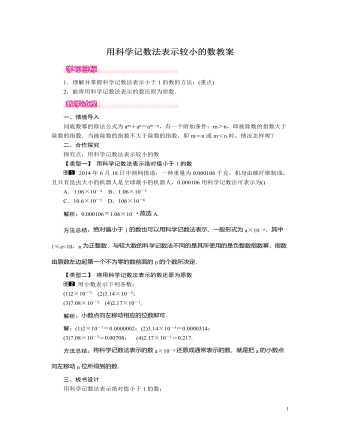
北师大初中七年级数学下册用科学记数法表示较小的数教案
方法总结:绝对值小于1的数也可以用科学记数法表示,一般形式为a×10-n,其中1≤a<10,n为正整数.与较大数的科学记数法不同的是其所使用的是负整数指数幂,指数由原数左边起第一个不为零的数前面的0的个数所决定.【类型二】 将用科学记数法表示的数还原为原数用小数表示下列各数:(1)2×10-7; (2)3.14×10-5;(3)7.08×10-3; (4)2.17×10-1.解析:小数点向左移动相应的位数即可.解:(1)2×10-7=0.0000002;(2)3.14×10-5=0.0000314;(3)7.08×10-3=0.00708; (4)2.17×10-1=0.217.方法总结:将科学记数法表示的数a×10-n还原成通常表示的数,就是把a的小数点向左移动n位所得到的数.三、板书设计用科学记数法表示绝对值小于1的数:一般地,一个小于1的正数可以表示为a×10n,其中1≤a<10,n是负整数.从本节课的教学过程来看,结合了多种教学方法,既有教师主导课堂的例题讲解,又有学生主导课堂的自主探究.课堂上学习气氛活跃,学生的学习积极性被充分调动,在拓展学生学习空间的同时,又有效地保证了课堂学习质量

人教版新课标高中物理必修1物理学与人类文明教案2篇
1. 课前观看视频《物理学与人类文明》2. 分组讨论,派代表发言,谈学习感受。主要是物理的地位,物理的学习方法。3. 高中物理与初中物理在内容和方法上的区别高中物理除了现象、概念和规律之外还应该关注研究问题的方法,学会从先想到抽象,从定性到定量研究问题,学会用数学方法解决物理问题,学会实验探究,学会独立分析问题解决问题的思维习惯。4. 高中物理学习的基本要求高中物理学习应该“重视实验,勤于思考”和“经历过程,体验方法”。高中物理学习与初中物理学习虽然有一定区别,但也不是孤立的,要继续坚持初中物理学习中积累的学习方法和体会,重视从正反两个方面加以总结和提炼,做到:(1) 认真阅读,学会自学要学好物理,就要认真阅读课本。阅读课本是要抓住关键词语,弄清语句间的逻辑顺序和因果关系,领会文章段落所表达的物理内容,掌握课本叙述物理问题的表达方法。

人教版新课标高中物理必修1物理学与人类文明教案2篇
八、物理学的基础地位及物理学对人类文明、社会进步的影响。(1) 情景一:磁悬浮实验:找两个空心的圆柱片磁铁,同名磁极相对,穿在同一根竹筷上,用手压下上面的磁铁,松手观察它的运动情况。问题1:上面的磁铁为什么会跳起来,为什么会悬浮在下面的磁铁上方?问题2:根据这个实验,你会想到那一种交通工具?总结:人们就是从磁悬浮现象中得到启发,进行磁悬浮列车的研究和制造的,这说明物理学在推动社会进步、人类文明方面起到推动作用。(2) 情景二:感应起电和火花放电实验:用感应起电机或感应圈产生火花放电,让学生观察现象,闻气味,然后联想生活实例。还可以用一张纸试着挡住放电的弧光,最好能引燃纸张,说明雷击引起火灾的现象。问题1:你看、听到了什么现象?问题2:根据这个实验,你会想到那一种自然现象?问题3:放电发生在什么地方?为什么建筑物上方都有尖尖的设置,是干什么用的?问题4:你闻到什么气味了吗?
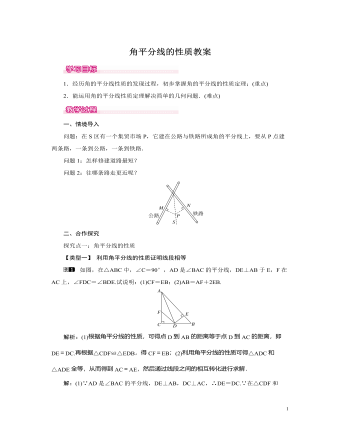
北师大初中七年级数学下册角平分线的性质教案
解析:根据AB∥CD,∠ACD=120°,得出∠CAB=60°.再根据尺规作图得出AM是∠CAB的平分线,即可得出∠MAB的度数.解:∵AB∥CD,∴∠ACD+∠CAB=180°.又∵∠ACD=120°,∴∠CAB=60°.由尺规作图知AM是∠CAB的平分线,∴∠MAB=12∠CAB=30°.方法总结:通过本题要掌握角平分线的作图步骤,根据作图明确AM是∠BAC的角平分线是解题的关键.三、板书设计1.角平分线的性质:角平分线上的点到这个角的两边的距离相等.2.角平分线的作法本节课由于采用了动手操作以及讨论交流等教学方法,从而有效地增强了学生对角以及角平分线的性质的感性认识,提高了学生对新知识的理解与感悟,因而本节课的教学效果较好,学生对所学的新知识掌握较好,达到了教学的目的.不足之处是少数学生在性质的运用上还存在问题,需要在今后的教学与作业中进一步的加强巩固和训练
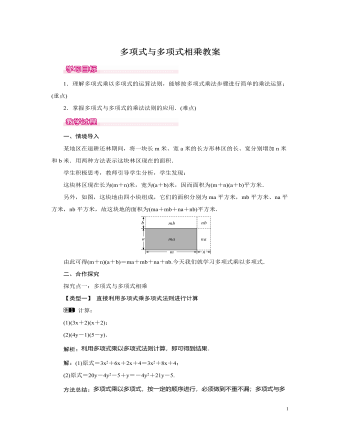
北师大初中七年级数学下册多项式与多项式相乘教案
解:(ax2+bx+1)(3x-2)=3ax3-2ax2+3bx2-2bx+3x-2.∵积不含x2项,也不含x项,∴-2a+3b=0,-2b+3=0,解得b=32,a=94,∴系数a、b的值分别是94,32.方法总结:解决此类问题首先要利用多项式乘法法则计算出展开式,合并同类项后,再根据不含某一项,可得这一项系数等于零,再列出方程解答.三、板书设计1.多项式与多项式的乘法法则:多项式和多项式相乘,先用一个多项式的每一项与另一个多项式的每一项相乘,再把所得的积相加.2.多项式与多项式乘法的应用本节知识的综合性较强,要求学生熟练掌握前面所学的单项式与单项式相乘及单项式与多项式相乘的知识,同时为了让学生理解并掌握多项式与多项式相乘的法则,教学中一定要精讲精练,让学生从练习中再次体会法则的内容,为以后的学习奠定基础
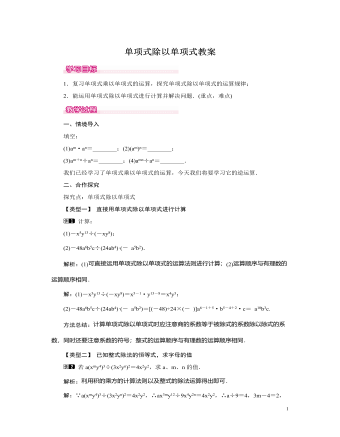
北师大初中七年级数学下册单项式除以单项式教案
光的速度约为3×108米/秒,一颗人造地球卫星的速度是8×103米/秒,则光的速度是这颗人造地球卫星速度的多少倍?解析:要求光速是人造地球卫星的速度的倍数,用光速除以人造地球卫星的速度,可转化为单项式相除问题.解:(3×108)÷(8×103)=(3÷8)·(108÷103)=3.75×104.答:光速是这颗人造地球卫星速度的3.75×104倍.方法总结:解整式除法的实际应用题时,应分清何为除式,何为被除式,然后应当单项式除以单项式法则计算.三、板书设计1.单项式除以单项式的运算法则:单项式相除,把系数、同底数幂分别相除,作为商的因式;对于只在被除式里含有的字母,则连同它的指数作为商的一个因式.2.单项式除以单项式的应用在教学过程中,通过生活中的情景导入,引导学生根据单项式乘以单项式的乘法运算推导出其逆运算的规律,在探究的过程中经历数学概念的生成过程,从而加深印象
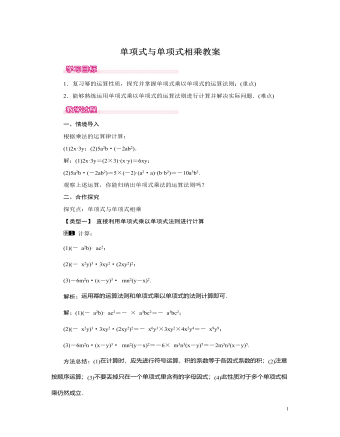
北师大初中七年级数学下册单项式与单项式相乘教案
解析:先求出长方形的面积,再求出绿化的面积,两者相减即可求出剩下的面积.解:长方形的面积是xym2,绿化的面积是35x×34y=920xy(m2),则剩下的面积是xy-920xy=1120xy(m2).方法总结:掌握长方形的面积公式和单项式乘单项式法则是解题的关键.三、板书设计1.单项式乘以单项式的运算法则:单项式相乘,把系数、同底数幂分别相乘,作为积的因式;对于只在一个单项式里面含有的字母,则连同它的指数作为积的一个因式.2.单项式乘以单项式的应用本课时的重点是让学生理解单项式的乘法法则并能熟练应用.要求学生在乘法的运算律以及幂的运算律的基础上进行探究.教师在课堂上应该处于引导位置,鼓励学生“试一试”,学生通过动手操作,能够更为直接的理解和应用该知识点
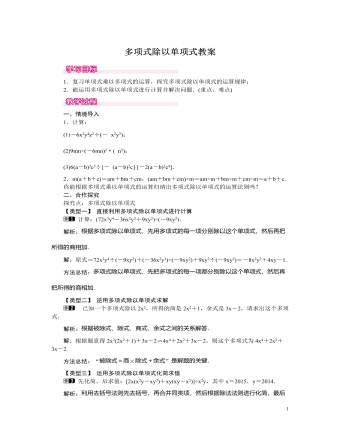
北师大初中七年级数学下册多项式除以单项式教案
一、情境导入1.计算:(1)-6x3y4z2÷(-23x2y2);(2)9mn÷(-6mn)2·(13n2);(3)6(a-b)3c5÷[-35(a-b)2c]·[-2(a-b)3c4].2.m(a+b+c)=am+bm+cm,(am+bm+cm)÷m=am÷m+bm÷m+cm÷m=a+b+c.你能根据多项式乘以单项式的运算归纳出多项式除以单项式的运算法则吗?二、合作探究探究点:多项式除以单项式【类型一】 直接利用多项式除以单项式进行计算计算:(72x3y4-36x2y3+9xy2)÷(-9xy2).解析:根据多项式除以单项式,先用多项式的每一项分别除以这个单项式,然后再把所得的商相加.解:原式=72x3y4÷(-9xy2)+(-36x2y3)÷(-9xy2)+9xy2÷(-9xy2)=-8x2y2+4xy-1.方法总结:多项式除以单项式,先把多项式的每一项都分别除以这个单项式,然后再把所得的商相加.
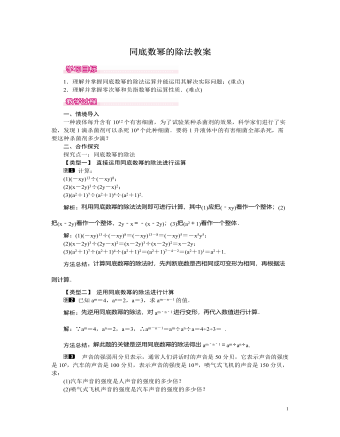
北师大初中七年级数学下册同底数幂的除法教案
【类型四】 含整数指数幂、零指数幂与绝对值的混合运算计算:-22+(-12)-2+(2015-π)0-|2-π2|.解析:分别根据有理数的乘方、零指数幂、负整数指数幂及绝对值的性质计算出各数,再根据实数的运算法则进行计算.解:-22+(-12)-2+(2015-π)0-|2-π2|=-4+4+1-2+π2=π2-1.方法总结:熟练掌握有理数的乘方、零指数幂、负整数指数幂及绝对值的性质是解答此题的关键.三、板书设计1.同底数幂的除法法则:同底数幂相除,底数不变,指数相减.2.零次幂:任何一个不等于零的数的零次幂都等于1.即a0=1(a≠0).3.负整数次幂:任何一个不等于零的数的-p(p是正整数)次幂,等于这个数p次幂的倒数.即a-p=1ap(a≠0,p是正整数).从计算具体问题中的同底数幂的除法,逐步归纳出同底数幂除法的一般性质.教学时要多举几个例子,让学生从中总结出规律,体验自主探究的乐趣和数学学习的魅力,为以后的学习奠定基础
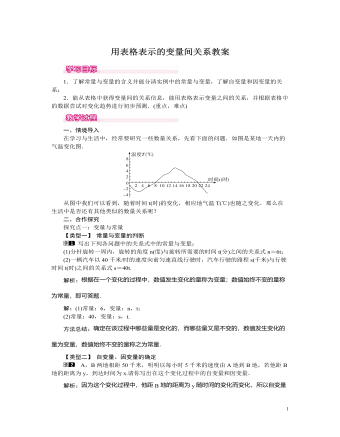
北师大初中七年级数学下册用表格表示的变量间关系教案
解:(1)电动车的月产量y为随着时间x的变化而变化,有一个时间x就有唯一一个y与之对应,月产量y是时间x的因变量;(2)6月份产量最高,1月份产量最低;(3)6月份和1月份相差最大,在1月份加紧生产,实现产量的增值.方法总结:观察因变量随自变量变化而变化的趋势,实质是观察自变量增大时,因变量是随之增大还是减小.三、板书设计1.常量与变量:在一个变化过程中,数值发生变化的量为变量,数值始终不变的量称之为常量.2.用表格表示数量间的关系:借助表格表示因变量随自变量的变化而变化的情况.自变量和因变量是用来描述我们所熟悉的变化的事物以及自然界中出现的一些变化现象的两个重要的量,对于我们所熟悉的变化,在用了这两个量的描述之后更加鲜明.本节是学好本章的基础,教学中立足于学生的认知基础,激发学生的认知冲突,提升学生的认知水平,使学生在原有的知识基础上迅速迁移到新知上来
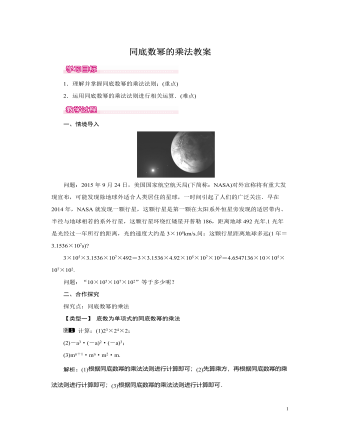
北师大初中七年级数学下册同底数幂的乘法教案
问题:2015年9月24日,美国国家航空航天局(下简称:NASA)对外宣称将有重大发现宣布,可能发现除地球外适合人类居住的星球,一时间引起了人们的广泛关注.早在2014年,NASA就发现一颗行星,这颗行星是第一颗在太阳系外恒星旁发现的适居带内、半径与地球相若的系外行星,这颗行星环绕红矮星开普勒186,距离地球492光年.1光年是光经过一年所行的距离,光的速度大约是3×105km/s.问:这颗行星距离地球多远(1年=3.1536×107s)?3×105×3.1536×107×492=3×3.1536×4.92×105×107×102=4.6547136×10×105×107×102.问题:“10×105×107×102”等于多少呢?二、合作探究探究点:同底数幂的乘法【类型一】 底数为单项式的同底数幂的乘法计算:(1)23×24×2;(2)-a3·(-a)2·(-a)3;(3)mn+1·mn·m2·m.解析:(1)根据同底数幂的乘法法则进行计算即可;(2)先算乘方,再根据同底数幂的乘法法则进行计算即可;(3)根据同底数幂的乘法法则进行计算即可.

